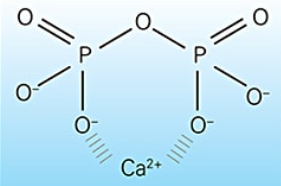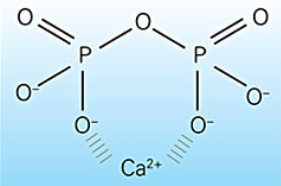Ingredient spotlight: sodium tripolyphosphate
- Nutrition
- Dog
- Cat
Sodium tripolyphosphate is the active ingredient in our Wholesome Blend® Naturally Fresh formulas that supports dental health in dogs and cats by reducing calculus/tartar formation.

Calculus/tartar contribution to periodontal disease
The most common disorder affecting dogs and cats is periodontal disease (for more information check out our resource on periodontal disease here), the primary cause being bacterial plaque.
Within minutes of a tooth being cleaned, whether it be professionally or by the mechanical cleaning (brushing) effect of kibble, a sticky film forms on the tooth and starts to accumulate bacteria from the natural microflora of the mouth. This is bacterial plaque. Left undisturbed, calcium from saliva and food is deposited into the plaque, creating a hard, porous material known as calculus/tartar.
While calculus/tartar is not the primary cause of periodontal disease, it contributes to its progression. Its rough and porous surface promotes more bacteria attachment to the tooth and the hard, calcified material can only be removed during a professional dental cleaning. Once calculus/tartar forms, home oral hygiene measures (tooth brushing, dental diets, dental treats) are ineffective. This is why prevention of calculus/tartar formation is essential in supporting oral hygiene.
Reducing the formation of calculus/tartar
Pyrophosphates and longer chain polyphosphates are compounds that are powerful sequestrants. Sequestrants are used to bind cations, making them unavailable for reactions. Time-travelling back to chemistry class, cations are positively charged and are attracted to the negatively charged sequestrants (opposite charges attract). Due to this property pyrophosphates and polyphosphates have been used in a variety of different industries.

Figure 1: Sequestering agent (pyrophosphate) binding to cation (calcium).
For decades, pyrophosphates have been used in human toothpastes for their efficacy in reducing calculus/tartar and supporting healthy gums. Pyrophosphates (negatively charged) block calcium (positively charged) from depositing into plaque by binding to calcium in the saliva and on the tooth, and they bind to receptors on the tooth, blocking sites for calcium. With calcium unable to be deposited into plaque, there is a reduction in the formation of calculus/tartar.

Figure 2:
Left: Sodium tripolyphosphate binds to calcium on the tooth’s surface, making calcium unavailable to form calculus/tartar.
Right: Calcium and other minerals are freely deposited into the plaque, permitting calculus/tartar to form.
Ingredient safety
Sodium tripolyphosphate is Generally Recognized as Safe (GRAS) in animal feeds by the Association of American Feed Control Officials. This means that under the conditions of intended use, experts qualified to evaluate the safety of sodium tripolyphosphate have deemed it safe to use.
After pyrophosphate binds to calcium and is swallowed, pyrophosphate is degraded by enzymes in the gastrointestinal tract and the calcium swallowed becomes a dietary source for the body.
Sources
Association of American Feed Control Officials. 2019 Official Publication: Part 582 Substances Generally Recognized as Safe in Animal Feeds.
Bellows, J., Berg, M. L., Dennis, S., Harvey, R., Lobprise, H. B., Snyder, C. J., Stone, A. E. S & Van de Wetering, A. G. (2019). 2019 AAHA Dental Care Guidelines for Dogs and Cats. Journal of the American Animal Hospital Association, 55(2):49-69.
DentalCare. (n.d). Fundamentals of Dentifrice: Oral Health Benefits in a Tube [Image]. Retrieved from https://www.dentalcare.com/en-us/professional-education/ce-courses/ce410/calculus-control.
Hennet, P. H., Servet, E., Soulard, Y & Biourge V. (2008). Effect of Pellet Food Size and Polyphosphates in Preventing Calculus Accumulation in Dogs. Journal of Veterinary Dentistry 24(4):236-9.
Lund, E. M., Armstrong, P.J, Kirk, C. A., Kolar, L. M & Klausner, J. S. (1999). Health status and population characteristics of dogs and cats examined at private veterinary practices in the United States. Journal of the American Veterinary Medical Association, 214:1336–1341.
McFadden, T., Marretta, S. M. (2013). Consequences of Untreated Periodontal Disease in Dogs and Cats. Journal of Veterinary Dentistry, 30(4):266-275.
Niemiec, B. A. (2008). Periodontal Disease. Topics in Companion Animal Medicine, 23(2):72-80.
Orriss, I. R., Arnett, T. R & Russell, G. G. (2016). Pyrophosphate: a key inhibitor of mineralisation. Current Opinion in Pharmacology, 28: 57-68.
White, D. J & Gerlach, R. W. (2000). Anticalculus effects of a novel, dual-phase polypyrophosphate dentifrice: chemical basis, mechanism, and clinical response. The Journal of Contemporary Dental Practice, 1(4).
Jin, Y & Yip, H.K. (2002). Supragingival calculus: formation and control. Critical Reviews in Oral Biology & Medicine, 13: 426-441.